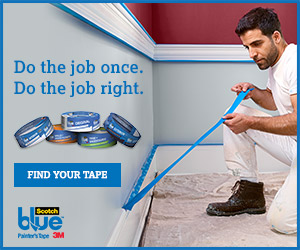 Jeff Malmer is an Advanced Application Engineering Specialist for 3M. He has 38 years of experience in developing and improving adhesives and tape products for a variety of applications. He also trains 3M customers, end-users and sales and marketing professionals on the various tape products the company produces. Here, he answers a question that has plagued pros and DIYers alike for years.
Jeff Malmer is an Advanced Application Engineering Specialist for 3M. He has 38 years of experience in developing and improving adhesives and tape products for a variety of applications. He also trains 3M customers, end-users and sales and marketing professionals on the various tape products the company produces. Here, he answers a question that has plagued pros and DIYers alike for years.
Q: What techniques do you suggest for preventing tape bleed and ragged lines?
A: Taping for a painting project seems pretty straightforward, but there are some small details that can be the difference between creating a crisp line and grappling with a ragged one. Tape bleed that results in ragged lines leaves an unprofessional appearance and can lead to callbacks. Here are a few tips to help you avoid this problem:
Avoid having one go-to tape; get the right tape for each surface. Painters can be creatures of habit. Some fall in love with their tools and techniques, and can be resistant to trying new products. When it comes to avoiding tape bleed, you need the right tape for the surface you’re prepping. Certain tapes are designed with gentler adhesives that are better for delicate surfaces, and there are a host of others that are very sticky and can even adhere to stucco and brick; then there are those perfect for baseboards and general interior painting environments, offering enough adhesion to avoid bleed while still going easy on the surface. Make sure you understand the tape needs for each project before you choose your tape(s).
Clean thoroughly. Pros know a clean surface is important for a coating to adhere. The same holds true for tape. But, too often, cleaning surfaces can be a rush job, much of it done with a damp rag. We recommend lukewarm water and trisodium phosphate (TSP). There are other cleaners that work well, too, but the main point here is that when we say ‘clean,’ we mean doing more than just wiping a surface off with a damp rag. And then, of course, don’t forget to allow enough time for the surface to dry adequately. This is a small detail that can go a long way with adhesion. And with better adhesion, you have a better chance of getting a crisp line.
Use a putty knife. It’s common for people to simply run their finger along tape to assure that it adheres to the surface. We recommend a putty knife be used to assure adherence, too. The flat surface of the blade provides a better opportunity to press on all areas of the tape, especially along baseboards or challenging areas where a finger may have difficulty accessing.
Think about your environment. Tape can be effectively applied in a wide temperature range, but 50˚–100˚ F is ideal. Avoid cold weather, if possible, as that can affect adhesion. Extreme heat (over 100˚) and high humidity can also negatively affect tape performance. Pay close attention to how your tape is performing early on; if you’re running into problems, you may need to switch to a different product with different adhesive properties to help with clean lines.
Score when possible. Some think that removing the tape while the paint is still wet helps produce a clean line. I think that’s a messy approach that doesn’t always assure us of a clean line. As a best practice, I prefer scoring the tape edge whenever possible. When scoring, allow the paint to dry and run a putty knife or razor blade along the edge of the tape where it meets the painted surface. Scoring is best done where trim and the wall come together, other situations don’t always allow for it. It’s important to recognize if you’re dealing with a situation where it’s not possible.
Don’t flood the tape edge. Some painters flood an edge with a coating to make sure they are getting the paint all the way into the corner where the wall meets the trim. The practice is unnecessary and can make the job messy, as it increases the likelihood for paint drips. Making sure you knife down the tape so that it adheres, and then apply enough paint without flooding are the best ways to avoid bleed and ragged lines.
In closing, taping can be tedious and frustrating to some. If you’re having trouble getting those crisp lines, slow down. Rushing only leads to bad habits—and callbacks.




